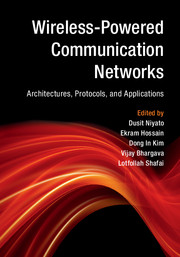Book contents
- Frontmatter
- Contents
- List of contributors
- Preface
- Part I Basics of Wireless Energy Harvesting and Transfer Technology
- Part II Architectures, Protocols, and Performance Analysis
- 4 Cooperative Networks with Wireless Energy Harvesting
- 5 Multiple Antennas and Beamforming for SWIPT Systems
- 6 Backscattering Wireless-Powered Communications
- 7 Dedicated Wireless Energy Harvesting in Cellular Networks: Performance Modeling and Analysis
- 8 Ambient Wireless Energy Harvesting in Small Cell Networks: Performance Modeling and Analysis
- Part III Applications of Wireless Energy Harvesting and Transfer
- Index
- References
5 - Multiple Antennas and Beamforming for SWIPT Systems
from Part II - Architectures, Protocols, and Performance Analysis
Published online by Cambridge University Press: 01 December 2016
- Frontmatter
- Contents
- List of contributors
- Preface
- Part I Basics of Wireless Energy Harvesting and Transfer Technology
- Part II Architectures, Protocols, and Performance Analysis
- 4 Cooperative Networks with Wireless Energy Harvesting
- 5 Multiple Antennas and Beamforming for SWIPT Systems
- 6 Backscattering Wireless-Powered Communications
- 7 Dedicated Wireless Energy Harvesting in Cellular Networks: Performance Modeling and Analysis
- 8 Ambient Wireless Energy Harvesting in Small Cell Networks: Performance Modeling and Analysis
- Part III Applications of Wireless Energy Harvesting and Transfer
- Index
- References
Summary
Introduction
The development of wireless communication networks worldwide has triggered an exponential growth in the number of wireless communication devices and sensors for applications such as e-health, automated control, environmental monitoring, energy management, and safety management. It is expected that, by 2020, the number of inter-connected devices on the planet may reach 50 billion. Recent efforts in next-generation communication system development aim at providing secure, ubiquitous, and high-speed communication with guaranteed quality of service (QoS). However, the related tremendous increase in the number of transmitters and receivers has also led to a huge demand for energy. A relevant technique for reducing the energy consumption of wireless devices is multiple-input multiple-output (MIMO), since it offers extra degrees of freedom for more efficient resource allocation. In particular, multiuser MIMO, where a transmitter equipped with multiple antennas serves multiple single-antenna receivers, is considered an effective solution for realizing the potential performance gains offered by multiple antennas to improve the system spectral efficiency and reduce the transmit power. On the other hand, battery-powered mobile devices such as wireless sensors have been widely deployed and have become critical components of many wireless communication networks over the past decades. However, batteries have limited energy storage capacity and their replacement can be costly or even impossible, which creates a performance bottleneck in wireless networks. As a result, energy harvesting technology is foreseen as a viable solution to remove the last wires of wireless devices. The integration of energy harvesting (EH) capabilities into communication devices facilitates self-sustainability of energy limited communication systems. Solar, wind, hydroelectric, and piezoelectric are the major conventional energy sources for EH. For instance, energy harvesters for harvesting wind and solar energy have been successfully integrated into base station transmitters for providing communication services in remote areas [1]. However, the availability of these natural energy sources is usually limited by location, climate, and time of day. Besides, the implementation of conventional energy harvesters may be problematic and renewable energy from natural sources may not be available in indoor environments. Thus, a new form of controllable energy source for portable wireless devices is needed in order to extend the lifetime of communication networks.
- Type
- Chapter
- Information
- Wireless-Powered Communication NetworksArchitectures, Protocols, and Applications, pp. 170 - 216Publisher: Cambridge University PressPrint publication year: 2016
References
- 1
- Cited by



